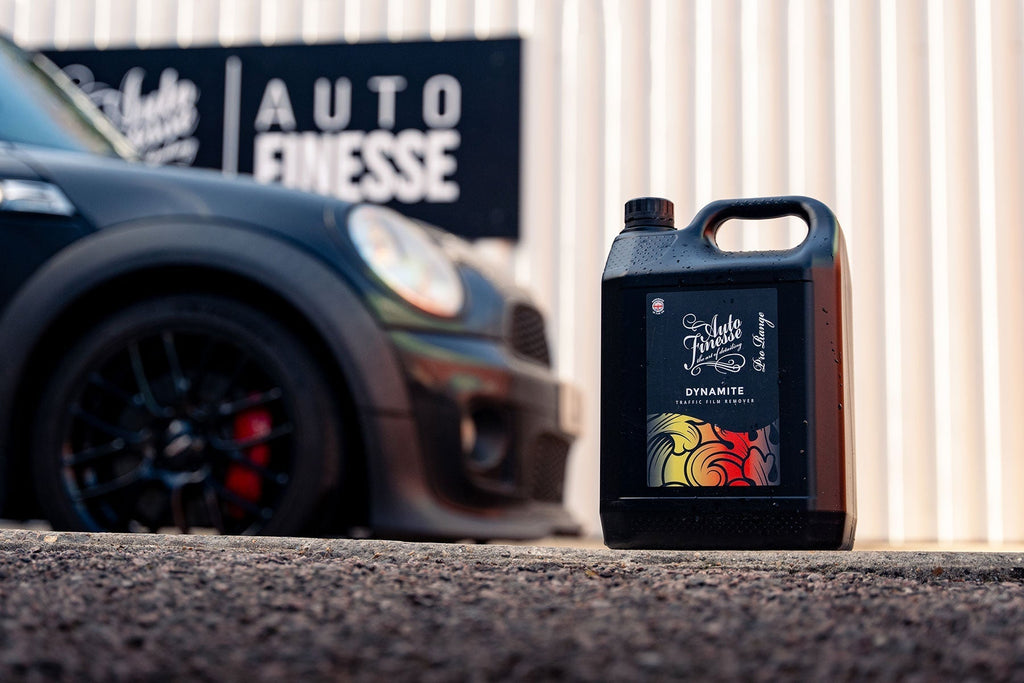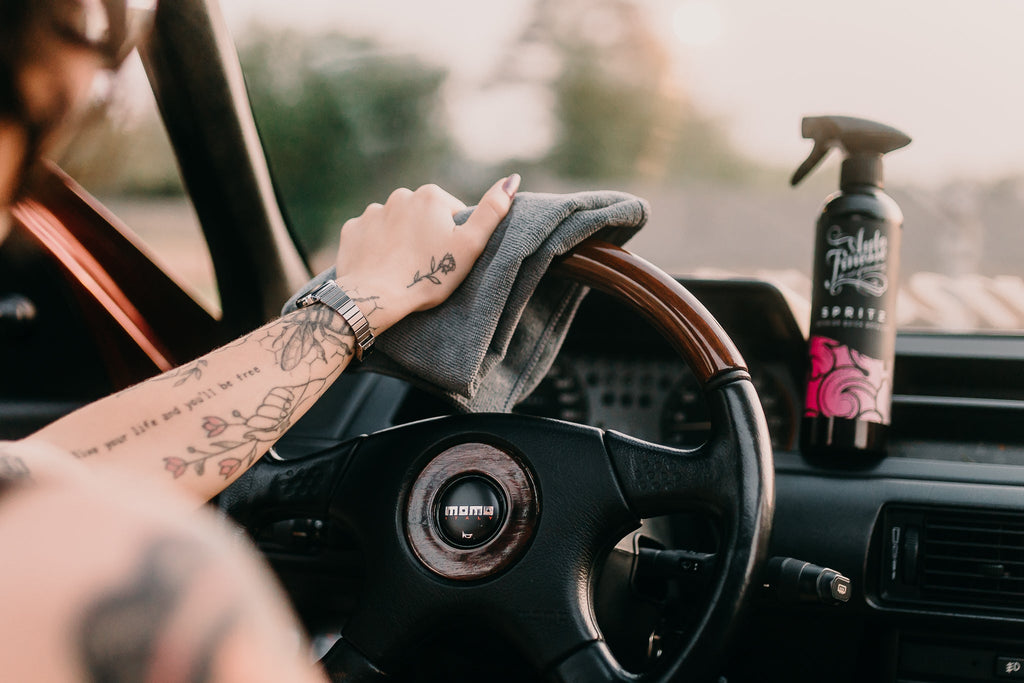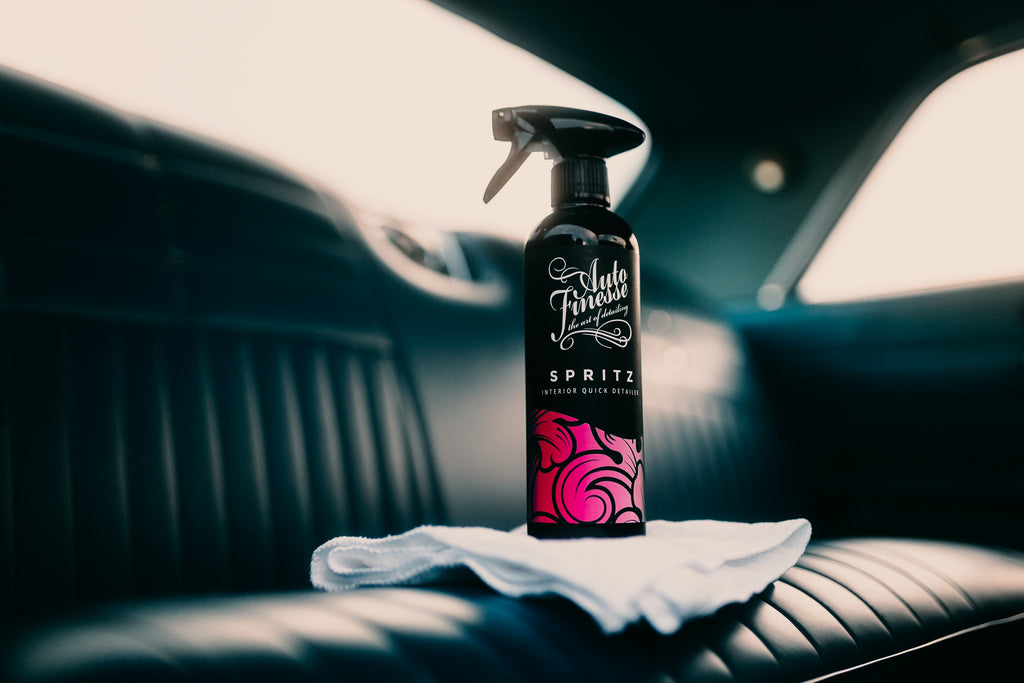PPF: How To Clean and Care for Paint Protection Film

IN THIS GUIDE:
- Discover how to care for a car with potentially vulnerable paint protection film.
- See the detailing products you can use to clean, decontaminate, restore and protect PPF.
- Learn the differences between PPF, paintwork and vinyl wraps, and how they may affect your detail.
There’s an old adage in the detailing world – Q: how do I clean PPF? A: Carefully.
But of course, there’s a lot more to it than that if you’re looking to detail any car fitted with paint protection film.
It is however a question that comes up often. What with the popularity of PPF as a dealer option on high-end cars, not to mention its extensive use in the modified car world, it does raise concerns on how PPF should be cared for, cleaned, protected and ultimately what detailing products you can use during routine maintenance and larger details.
But that’s where we’re here to help, so let’s take a closer look at PPF and how you can keep yours in the best condition….

What is PPF?
The idea of paint protection film may not be quite as modern as many believe. Originally developed for use on helicopters in the 1960s in the Vietnam war (and known at the time as 'heli-tape'), it’s purpose was a cost effective way of shielding military equipment from both shrapnel damage and the effects of the environment. Of course, the products we have nowadays have gone through a serious evolution, and they’re now designed to be transparent and glossy, but the fundamental principles remain the same.
PPF films are designed to shield your paintwork from abrasive and acidic contamination, such as general grime and bug splatter, along with stone chips and the effects of environmental elements such as UV fading. PPF also sields from the reaction of your paint or clearcoat with the oxygen in the air – what’s more commonly known as oxidation.
You can think of PPF as a bit like a clear vinyl wrap, only much, much thinner. Most paint protection films are made from thermoplastic urethane or polyurethane. The best ones may even have a top layer that incorporates a special elastomeric polymer that helps it maintain its shape, giving self-healing properties to cut down on the visual impact of light scratches and swirl marks when they occur.
But all this doesn’t mean that (even the best) PPF is bullet proof. Essentially you have an extremely thin, clear layer of plastic, and this isn’t going to be as hard as the paintwork itself. Self-healing or not, using heavy abrasive compounds and polishes like your would on the hard, glass-like surface of paint or clearcoat can damage PPF instead of restoring it. And, just like most vinyl wraps, the top layer of PPF is particularly sensitive to harsh cleaning chemicals and the application of protection layers that use strong solvent blends.
Unless you’re using the right protection, PPF films aren’t particularly hydrophobic, either. Dirt and water can cling to surfaces on a molecular level meaning that they have to be cleaned regularly to avoid them bonding with, and sometimes even absorbing, grime.

Where is PPF applied?
Even on older cars, it’s extremely common for cars to have PPF film applied from the factory but limited to areas of paintwork that suffer from the most impact from stone chips, heavy grime and road salt. Areas such as front bumpers, wing mirrors, leading bonnet edges and rear arches are the most common. Areas at risk of scratching from a lot of human contact are also popular with manufacturers, such as the boot ledge, door sils or door handle recesses. You’ll often find that factory PPF gets tired over the years, but assuming it's not peeling away or extremely hazy, most can be effectively restored.
These components are commonly fitted with aftermarket PPF films on a whole range of other cars, vans and pickups, too. Particularly from the dealers as a cost-effective stonechip shield. So, it’s worth inspecting closely because, although for the most part PPF is washed in the same way as the most sensitive paintjobs, it will need to be masked or avoided when machine polishing, or when adding certain kinds of protection.
But, let’s not forget that PPF is also used for protecting from UV and environmental contamination, and it’s the reason why some high-end cars will be fitted with either a full wrap on every panel, or PPF on selected panels such as the bumpers, full bonnet and arches.

What can I use to care for my PPF?
As we said, washing a car with PPF installed is not unlike caring for the most sensitive types of paintwork. The idea is to rid all surfaces of contamination safely, without causing any damage through abrasion. When it comes to PPF, the key to getting the ultimate swirl free wash is a combination of using the correct products and techniques to remove grime safely, no matter the level of soiling.
Rule number one of course, is to be careful with your pressure washer, especially on ‘part-wrapped’ and factory vehicles where the edges of the PPF may be exposed. In some cases its relatively easy to peel away the PPF or introduce water under the film, damaging the film and the adhesive. Even on full PPF wraps it’s important to avoid blasting the edges of panels, just like a vinyl wraps. So, instead of using the most intense water pressure, for the most part misting your washer lightly over panels is the answer when rinsing. Let the cleaning products do the work.
And it’s not just the wet work that’s important either. Using the correct detailing products PPF can be decontaminated, restored and protected, too. So, let’s grab a top-end car with PPF on the bonnet, bumpers, sills and rear arches and show you a few top tips and essential products from our professional detailers…



PPF Cleaning and Routine Maintenance
No matter the car, or the amount of PPF, we’re looking for a swirl-free wash. So we’d take on the cleaning in much the same way as any other detail.
First, we want to prevent cross contamination - or getting the heaviest grime on areas that we’ve already cleaned - by cleaning the dirtiest part of the car first. If the engine bay is being cleaned we’d start there. For most details though, including routine maintenance, we’ll start by cleaning the wheels.
The best products to use here are gentle, acid-free cleaners such as Imperial Wheel Cleaner and Revolution Wheel Soap. This is because, if they do get splashed onto the bodywork, they’re not going to harm or react with your PPF. They can also be used in the rare cases where the wheels themselves are protected with PPF. Clean your wheels as usual and be sure to rinse downwards and away from the rest of the car.






Next we can move onto the rest of the exterior with the all-important pre wash stage. Like all details, here we’re looking to remove the bulk of the grime with a contactless 2-stage pre wash process. This simply stops any sharp particles from being dragged across surfaces and causing damage later in the contact wash.
First a light rinse to remove any loose grime and then we use a specialist pre-cleaner like Citrus Power Bug & Grime Remover to shift the largest particles. After another rinse this is followed with the application of Avalanche Snow Foam, which is designed to linger on surfaces for as long as possible while it breaks down bonded and smaller particle contamination.
What’s most important here is that both products (just like the wheel cleaners we’ve just used) are surfactant-based cleaning agents. This means that they not only physically pull particulates from the surface on a molecular level, but they surround them and encapsulate them in the solution. This keeps them away from the surfaces and allows them to be rinsed away without making contact. This is what makes our cleaning agents so powerful, but gentle enough for use on all sensitive surfaces, including paint, vinyl, glass, plastic, rubber and of course, PPF.








Now we can remove any other grime particles with our contact wash. This is arguably the most wet work stage, chiefly because we’re touching surfaces, so we use a few safety measures to ensure that the process is as surface-safe as possible.
First the crucial cleaning products and accessories. Here we’re using Lather Car Shampoo as our cleaning agent which is ideal for PPF and sensitive paintwork for a couple of good reasons.
Again, it’s a surfactant-based cleaning agent, but it’s also classed as a lubricant, which means that it not only breaks away bonded grime, but it lubricates any sharp particles allowing them to slip over surfaces without scratching. Lather also contains no waxes or fillers, so it won’t try to leave anythink else bonded to your PPF.










Lather Car Shampoo is a powerful blend of advanced surfactants and highly-concentrated lubricants, designed to make your contact wash easier - and safer - than... See product details More
Second a two-bucket wash is arguably even more essential when caring for PPF. As always, we have one bucket for our shampoo solution and one to rinse out our wash media between passes. This cuts down on the chance of getting dirt and grit in your wash bucket, and having it transferred back to the car.
Using our professional Detailing Buckets or Mini Detailing Buckets, which have grit guards and large capacities further reduces the risk of grime recirculation.

Finally, we have or wash media. Whether they’re constructed from lambswool or microfibre all of our professional Wash Mitts, and the Plush Wash Pad we’re using here are designed to glide over surfaces picking shampoo residue and grime as they goes. In this way the best wash media is able to lock away any harmful particles deep within the pile until it’s rinsed out. Crucially keeping it away from the surfaces you're cleaning.
When taking on the bodywork we always wash in straight lines and tackle the cleaner areas first, another way to prevent dragging heavier grime from the dirtiest parts, to cleaner parts of the car. The idea is to make each area cleaner, not dirtier, right?
Start with the roof, windows and upper sides, move on to the bonnet and front bumper and finish up with the lower sides and the rear end. Essentially, you’re washing from the top down, but targeting the cleaner areas as you go. Particularly on the PPF portions remember to keep your wash media as slick and soapy as possible, especially when you’re nearing any edges PPF. Glide, don’t scrub, let the mitt do the work.





After a through rinse down (remember to mist and not blast away) we can complete the final maintenance task – the drying.
As well as the usual reasons why we never clean a car when it’s hot and always dry our cars immediately after washing (because the impurities in tap water will be deposited all over the vehicle as water marks when allowed to air dry) it’s also worth remembering that PPF may not be very hydrophobic. Even though we can sort that out later with a little advanced protection, it does mean that water will tend to cling on rather than run off after an initial detail. So, it needs to be mopped up quickly before it dries. Films are also more easily damaged by water marks. On paintwork they can often be removed by machine polishing, but you can’t do that with PPF.
The best way to dry your PPF, along with the rest of your car, is by using a super-soft microfibre drying towel like our Aqua Deluxe, or the Silk Drying Towel we’re using here. By passing them over the surfaces (from the top down) we can safely absorb all the water and impurities together. By absorbing the water, rather than merely pushing it around like you would with a chamois, you get the safest, streak and scratch-free drying.

Targeted Decontamination
There may be instances when a little targeted decontamination is needed to remove sticky resides such as road tar and rubber marks. There’s no doubt that this car has seen its fair share of track time after all, but removing these is relatively easy, even on areas protected with PPF.
On normal paintwork and clearcoat we’d use a strong solvent like ObliTARate Tar & Glue Remover to break down, dissolve and encapsulate the sticky residues, allowing them to be wiped away. In the case of PPF, Crystal Glass Cleaner has much the same effect, but it’s made up of a far milder blend of fast flashing solvents that won’t soften the surface of the film, or the adhesive itself.
To remove marks simply spray Crystal on directly and immediately wipe lightly with a soft microfibre Work Cloth.



PPF Restoration
When older PPF fades (or even newer PPF when it picks up light scratches and swirls) essentially it blocks the view of the paintwork by reflecting light in different directions. This makes the surface appear dull, hazy and with hardly any depth, just the same as paintwork when it’s all scratched and swirly.
Now, although using heavy abrasives and machine polishers will essentially make matters worse by scratching the relatively soft film even more, it is possible to restore tired areas of PPF with a little hand polishing and some Tripple All-in-One Polish.
Tripple uses abrasives and deep cleaning solvents to clean away oxidation and lightly restore surfaces. Although technically it is an abrasive polish, the advanced diminishing abrasives are so fine they’re not going to damage the thin layer of plastic or polymer they’re acting on. This makes Tripple ideal for freshening up small areas by lightly refining and deep-cleaning at the same time. This process also helps to remove any light swirls and scratches to make light bounce back more uniformly, giving the appearance of depth and shine.
On a small area at a time use a Polish Pad or Microfibre Applicator to gently work in your Tripple in small circular motions, let it haze and wipe away the residue. Quick, simple and effective!



PPF Protection
The easy way to protect your PPF, while adding plenty of shine along the way, is using Graphene Liquid Filler Wax to seal the surface on a molecular level. Not only will this give you hard-layer protection that lasts for up to 12 months, but the hydrophobic and easy-clean benefits are off the scale too.
Graphene is one of our most advanced protection products and a next-generation, non abrasive sealant which forms an impermeable, glass-like layer to water and grime for extreme beading and sheeting. This of course, has the added benefit that it not only keeps your PFF cleaner for longer, but it makes it much easier to safely remove any grime the next time you wash your car. The great thing about Graphene is that it gives the same benefits on paintwork, too. So you can treat your whole car to the hardiest protection available without having to change products.
Graphene - as the name would suggest - contains graphene, a form of carbon that’s harder than steel and more flexible that’s rubber. It’s basically manifests as a single layer of carbon molecules that bond to surfaces to offer hard layer protection that’s resilient to abrasion, cleaning chemicals and UV radiation. Another reason it’s ideal for protection the relativity soft, scratchabe surface of paintwork protection films.
Using a Polish Pad or Foam Applicator simply apply a few drops of Graphene to each panel, before removing any residue and buffing to a high shine with a soft microfibre cloth.










An advanced liquid paintwork sealant developed to add extreme gloss and durable, ultra-hydrophobic protection that lasts for up to 12-months, Graphene Filler L... See product details More
So, that’s our top tips for caring for any car with PPF. Why not adapt this guide to your own car and push your detail to the next level?
For more top detailing guides and product spotlights check out the Guides Section Of Our Blog.


















































